1. Andrushko VA, Verano JW. Prehistoric trepanation in the Cuzco region of Peru: a view into an ancient Andean practice. Am J Phys Anthropol. 2008; 137:4–13. PMID:
18386793.

2. Apfelbaum RI, Guthkelch AN, Shulman K. Experimental production of subdural hematomas. J Neurosurg. 1974; 40:336–346. PMID:
4813715.

3. Bereczki Z, Marcsik A. Trephined skulls from ancient populations in Hungary. Acta Medica Lithuanica. 2005; 12:65–69.
4. Campillo D. Neurosurgical pathology in prehistory. Acta Neurochir (Wien). 1984; 70:275–290. PMID:
6369893.

5. Capasso L, Michetti E, Pierfelice L, D'Anastasio R. Neurosurgery 7000 years ago in central Italy. Lancet. 2002; 359:2206. PMID:
12091016.

6. Cha KH, Kim CH, Lee HK, Moon JG, Cho TG. The Clinical Course of Subdural Hygroma with Head Injury. Korean J Neurotrauma. 2013; 9:125–130.

7. Clower WT, Finger S. Discovering trepanation: the contribution of Paul Broca. Neurosurgery. 2001; 49:1417–1425. discussion 1425-1426PMID:
11846942.

8. Cooper PR. Traumatic intracranial hematomas. In : Wilkins RH, Rengachary SS, editors. Neurosurgery. New York: McGraw-Hill;vol 2:p. 1657–1661. p. 1985
9. D'Abbondanza JA, Loch Macdonald R. Experimental models of chronic subdural hematoma. Neurol Res. 2014; 36:176–188. PMID:
24172841.
10. D'Errico AP, German WJ. Chronic Subdural Hematoma. Yale J Biol Med. 1930; 3:11–20. PMID:
21433469.
11. Dierckx RA, Bruyland M, Nuyens Z, Stadnik T, Solheid C, Ebinger G. Non-traumatic subdural hygroma. Acta Neurol Belg. 1989; 89:352–357. PMID:
2517182.
12. Ellis H. The Cambridge illustrated history of surgery. Cambridge: Cambridge University Press;2009.
13. Endtz LJ. Post-traumatic hygroma in the eighteenth century: described by Thomas Schwencke. Surg Neurol. 1978; 10:305–307. PMID:
364709.
14. Friede RL, Schachenmayr W. The origin ofsubdural neomembranes. II. Fine structural of neomembranes. Am J Pathol. 1978; 92:69–84. PMID:
686149.
15. Gardner WJ. Traumatic subdural hematoma with particular reference to the latent interval. Arch Neurol Psychiatry. 1932; 27:847–858.

16. Gitlin D. Pathogenesis of subdural collections of fluid. Pediatrics. 1955; 16:345–352. PMID:
13245339.

17. Gross CG. A hole in the head. Neuroscientist. 1999; 5:263–269.

18. Haines DE. On the question of a subdural space. Anat Rec. 1991; 230:3–21. PMID:
2064027.

19. Haines DE, Harkey HL, al-Mefty O. The "subdural" space: a new look at an outdated concept. Neurosurgery. 1993; 32:111–120. PMID:
8421539.
20. Han K, Chen X. The archaeological evidence of trepanation in early China. Indo-Pac Prehist Assoc Bull. 2007; 27:22–27.

21. Hasegawa M, Yamashima T, Yamashita J, Suzuki M, Shimada S. Traumatic subdural hygroma: pathology and meningeal enhancement on magnetic resonance imaging. Neurosurgery. 1992; 31:580–585. PMID:
1407439.
22. Hoff J, Bates E, Barnes B, Glickman M, Margolis T. Traumatic subdural hygroma. J Trauma. 1973; 13:870–876. PMID:
4743143.

23. Ishibashi A, Yokokura Y, Miyagi J. Clinical analysis of nineteen patients with traumatic subdural hygromas. Kurume Med J. 1994; 41:81–85. PMID:
7967442.

24. Ito H, Komai T, Yamamoto S. Fibrinolytic enzyme in the lining walls of chronic subdural hematoma. J Neurosurg. 1978; 48:197–200. PMID:
146730.

25. Ito H, Yamamoto S, Komai T, Mizukoshi H. Role of local hyperfibrinolysis in the etiology of chronic subdural hematoma. J Neurosurg. 1976; 45:26–31. PMID:
132513.

26. Kaufman MH, Whitaker D, McTavish J. Differential diagnosis of holes in the calvarium: application of modern clinical data to palaeopathology. J Archaeol Sci. 1997; 24:193–218.

27. Kawano N, Endo M, Saito M, Yada K. [Origin of the capsule of a chronic subdural hematoma--an electron microscopy study]. No Shinkei Geka. 1988; 16:747–752. PMID:
3412561.
28. Kim DJ. The appeal of holes in the head. In : Whitelaw WA, editor. The Proceedings of the 13th annual history of medicine days. Calgary, CA: Faculty of Medicine;University of Calgary;2004. p. 17–24.
29. Koizumi H, Fukamachi A, Wakao T, Tasaki T, Nagaseki Y, Yanai Y. [Traumatic subdural hygromas in adults--on the possibility of development of chronic subdural hematoma (author's transl)]. Neurol Med Chir (Tokyo). 1981; 21:397–406. PMID:
6165911.
30. Kurin DS. Trepanation in South-Central Peru during the early late intermediate period (ca. AD 1000-1250). Am J Phys Anthropol. 2013; 152:484–494. PMID:
24142537.
31. Lee KS. Natural history of chronic subdural haematoma. Brain Inj. 2004; 18:351–358. PMID:
14742149.
32. Lee KS. The pathogenesis and clinical significance of traumatic subdural hygroma. Brain Inj. 1998; 12:595–603. PMID:
9653522.

33. Lee KS, Bae WK, Bae HG, Yun IG. The fate of traumatic subdural hygroma in serial computed tomographic scans. J Korean Med Sci. 2000; 15:560–568. PMID:
11068995.

34. Lee KS, Bae WK, Park YT, Yun IG. The pathogenesis and fate of traumatic subdural hygroma. Br J Neurosurg. 1994; 8:551–558. PMID:
7857535.

35. Lee KS, Doh JW, Bae HG, Yun IG. Relations among traumatic subdural lesions. J Korean Med Sci. 1996; 11:55–63. PMID:
8703371.

36. Lee KS, Shim JJ, Yoon SM, Doh JW, Yun IG, Bae HG. Acute-on-chronic subdural hematoma: not uncommon events. J Korean Neurosurg Soc. 2011; 50:512–516. PMID:
22323938.

37. Liau LM, Bergsneider M, Becker DP. Pathology and pathophysiology of head injury. In : Youmans JR, editor. Neurological surgery. ed 4. Philadelphia: Saunders;1996. Vol 3:p. 1549–1594.
38. López B, Caro L, Pardiñas AF. Evidence of trepanations in a medieval population (13th-14th century) of northern Spain (Gormaz, Soria). Anthropol Sci. 2011; 119:247–257.
39. Lv X, Li Z, Li Y. Prehistoric skull trepanation in China. World Neurosurg. 2013; 80:897–899. PMID:
23022649.

40. Marino R Jr, Gonzales-Portillo M. Preconquest Peruvian neurosurgeons: a study of Inca and pre-Columbian trephination and the art of medicine in ancient Peru. Neurosurgery. 2000; 47:940–950. PMID:
11014434.

41. Markwalder TM. Chronic subdural hematomas: a review. J Neurosurg. 1981; 54:637–645. PMID:
7014792.

42. Missios S. Hippocrates, Galen, and the uses of trepanation in the ancient classical world. Neurosurg Focus. 2007; 23:E11. PMID:
17961050.

43. Mori K, Maeda M. Surgical treatment of chronic subdural hematoma in 500 consecutive cases: clinical characteristics, surgical outcome, complications, and recurrence rate. Neurol Med Chir (Tokyo). 2001; 41:371–381. PMID:
11561347.

44. Murata K. Chronic subdural hematoma may be preceded by persistent traumatic subdural effusion. Neurol Med Chir (Tokyo). 1993; 33:691–696. PMID:
7505896.

45. Naffziger HC. Subdural fluid accumulations following head injury. J Am Med Assoc. 1924; 82:1751–1752.

46. Naganuma H, Fukamachi A, Kawakami M, Misumi S, Nakajima H, Wakao T. Spontaneous resolution of chronic subdural hematomas. Neurosurgery. 1986; 19:794–798. PMID:
3785628.

47. Ohno K, Suzuki R, Masaoka H, Matsushima Y, Inaba Y, Monma S. Chronic subdural haematoma preceded by persistent traumatic subdural fluid collection. J Neurol Neurosurg Psychiatry. 1987; 50:1694–1697. PMID:
3437306.

48. Oka H, Motomochi M, Suzuki Y, Ando K. Subdural hygroma after head injury. A review of 26 cases. Acta Neurochir (Wien). 1972. 1972; 26:265–273.
49. Oppenheim H. Textbook of nervous diseases for physicians and students. ed 5. New York: Otto Schulze and Company;1911.
50. Panourias IG, Skiadas PK, Sakas DE, Marketos SG. Hippocrates: a pioneer in the treatment of head injuries. Neurosurgery. 2005; 57:181–189. discussion 181-189PMID:
15987554.

51. Park CK, Choi KH, Kim MC, Kang JK, Choi CR. Spontaneous evolution of posttraumatic subdural hygroma into chronic subdural haematoma. Acta Neurochir (Wien). 1994; 127:41–47. PMID:
7942180.

52. Park HB, Lee CR, Kim SC. Chronic subdural hematoma superimposed on posttraumatic subdural hygroma: a report of three cases. J Korean Neurosurg Soc. 1990; 19:126–130.
53. Park HR, Lee KS, Shim JJ, Yoon SM, Bae HG, Doh JW. Multiple Densities of the Chronic Subdural Hematoma in CT Scans. J Korean Neurosurg Soc. 2013; 54:38–41. PMID:
24044079.

54. Parlato C, Guarracino A, Moraci A. Spontaneous resolution of chronic subdural hematoma. Surg Neurol. 2000; 53:312–315. discussion 315-317PMID:
10825513.

55. Putnam TJ, Cushing H. Chronic subdural hematoma: its pathology, its relation to pachymeningitis hemorrhagica, and its surgical treatment. Arch Surg. 1925; 11:329–393.
56. Quatrehomme G, Işcan MY. Postmortem skeletal lesions. Forensic Sci Int. 1997; 89:155–165. PMID:
9363624.

57. Rabe EF, Flynn RE, Dodge PR. A study of subdural effusions in an infant. With particular reference to the mechanisms of their persistence. Neurology. 1962; 12:79–92. PMID:
14489575.

58. Rosen HM, Simeone FA. Spontaneous subdural hygromas: a complication following craniofacial surgery. Ann Plast Surg. 1987; 18:245–247. PMID:
3592512.

59. Sankhyan AR, Weber GHJ. Evidence of surgery in Ancient India: trepanation at Burzahom (Kashmir) over 4000 years ago. Int J Osteoarchaeol. 2001; 11:375–380.

60. Sato S, Suzuki J. Ultrastructural observations of the capsule of chronic subdural hematoma in various clinical stages. J Neurosurg. 1975; 43:569–578. PMID:
1181389.

61. Schachenmayr W, Friede RL. The origin of subdural neomembranes. I. Fine structure of the dura-arachnoid interface in man. Am J Pathol. 1978; 92:53–68. PMID:
686148.
62. Seo DH, Lee KS, Shim JJ, Yoon SM. Multiple episodes of hemorrhage identified in MRI of chronic subdural hematomas. Korean J Neurotrauma. 2014; 10:22–25.

63. Sohn IT, Lee KS, Doh JW, Bae HG, Yun IG, Byun BJ. A prospective study on the incidence, patterns and premorbid conditions of traumatic subdural hygroma. J Korean Neurosurg Soc. 1997; 26:87–93.
64. Stone JL, Miles ML. Skull trepanation among the early Indians of Canada and the United States. Neurosurgery. 1990; 26:1015–1019. discussion 1019-1020PMID:
2194137.

65. Sun TF, Boet R, Poon WS. Non-surgical primary treatment of chronic subdural haematoma: preliminary results of using dexamethasone. Br J Neurosurg. 2005; 19:327–333. PMID:
16455539.

66. Taarnhoj P. Chronic subdural hematoma; historical review and analysis of 60 cases. Cleve Clin Q. 1955; 22:150–156. PMID:
13261320.

67. Taguchi Y, Nakamura N, Sato J, Hasegawa Y. [Pathogenesis of chronic subdural hematoma. Sequential study with computerized tomography (author's transl)]. Neurol Med Chir (Tokyo). 1982; 22:276–282. PMID:
6178999.
68. Takahashi Y, Mikami J, Sato H, Takeda S, Matsuoka T, Ito K, et al. [Analysis of chronic subdural hematoma based on CT (Part 2). Symptoms and CT findings (author's transl)]. Neurol Med Chir (Tokyo). 1982; 22:395–401. PMID:
6180342.
69. Trotter W. Chronic subdural hæmorrhage of traumatic origin, and its relation to pachymeningitis hæmorrhagica interna. Br J Surg. 1914; 2:271–291.

70. Tullo E. Trepanation and Roman medicine: a comparison of osteoarchaeological remains, material culture and written texts. J R Coll Physicians Edinb. 2010; 40:165–171. PMID:
20695173.

71. Velasco-Suarez M, Bautista Martinez J, Garcia Oliveros R, Weinstein PR. Archaeological origins of cranial surgery: trephination in Mexico. Neurosurgery. 1992; 31:313–318. discussion 318-319PMID:
1513436.
72. Verano JW. Trepanation in prehistoric South America: geographic and temporal trends over 2000 years. In : Arnott R, Finger S, Smith CUM, editors. Trepanation: history, discovery, theory. Leiden: Swets & Zeitlinger;2003. p. 223–236.
73. Watanabe S, Shimada H, Ishii S. Production of clinical form of chronic subdural hematoma in experimental animals. J Neurosurg. 1972; 37:552–561. PMID:
4627704.

74. Watters DA. Skull trepanation in the Bismarck archipelago. P N G Med J. 2007; 50:20–24. PMID:
19354008.
75. Weigel R, Krauss JK, Schmiedek P. Concepts of neurosurgical management of chronic subdural haematoma: historical perspectives. Br J Neurosurg. 2004; 18:8–18. PMID:
15040710.

76. Weir B. Oncotic pressure of subdural fluids. J Neurosurg. 1980; 53:512–515. PMID:
7420173.

77. Weir B. The osmolality of subdural hematoma fluid. J Neurosurg. 1971; 34:528–533. PMID:
5554357.

78. Wetterling T, Demierre B, Rama B, Nekic M. Protein analysis of subdural hygroma fluid. Acta Neurochir (Wien). 1988; 91:79–82. PMID:
3394551.

79. Whang K, Hu C, Hong SK, Kim HJ, Han YP, Pyen JS. Clinical analysis of chronic subdural hematoma originated from traumatic subdural hygroma. J Korean Neurosurg Soc. 1993; 22:898–904.
80. Wilberger JE. Pathophysiology of evolution and recurrence of chronic subdural hematoma. Neurosurg Clin N Am. 2000; 11:435–438. PMID:
10918012.

81. Yamada H, Nihei H, Watanabe T, Shibui S, Murata S. [Chronic subdural hematoma occurring consequently to the posttraumatic subdural hygroma--on the pathogenesis of the chronic subdural hematoma (author's transl)]. No To Shinkei. 1979; 31:115–121. PMID:
426938.
82. Yamada H, Watanabe T, Murata S, Shibui S, Nihei H, Kohno T, et al. Developmental process of chronic subdural collections of fluid based on CT scan findings. Surg Neurol. 1980; 13:441–448. PMID:
7414475.
83. Yamashima T, Yamamoto S. Clinicopathological classification of chronic subdural hematoma. Zentralbl Neurochir. 1985; 46:304–314. PMID:
3832696.
84. Yoon JW, Park IS, Park H, Kang DH, Park KB, Lee CH, et al. A study of the progression from acute subdural hematoma to chronic stage requiring surgical treatment. Korean J Neurotrauma. 2013; 9:74–80.

85. Zanini MA, de Lima Resende LA, de Souza Faleiros AT, Gabarra RC. Traumatic subdural hygromas: proposed pathogenesis based classification. J Trauma. 2008; 64:705–713. PMID:
18332811.

86. Zollinger R, Gross RE. Traumatic subdural hematoma: an explanation of the late onset of pressure symptoms. J Am Med Assoc. 1934; 103:245–249.
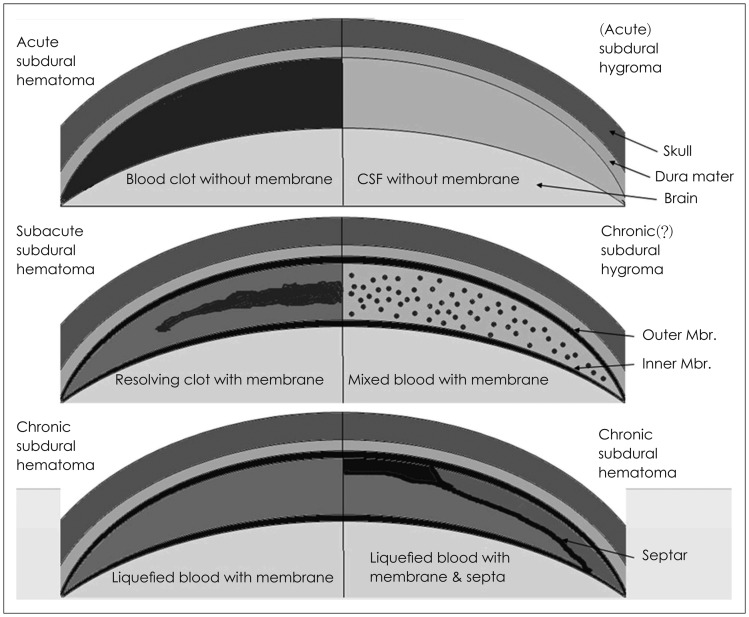
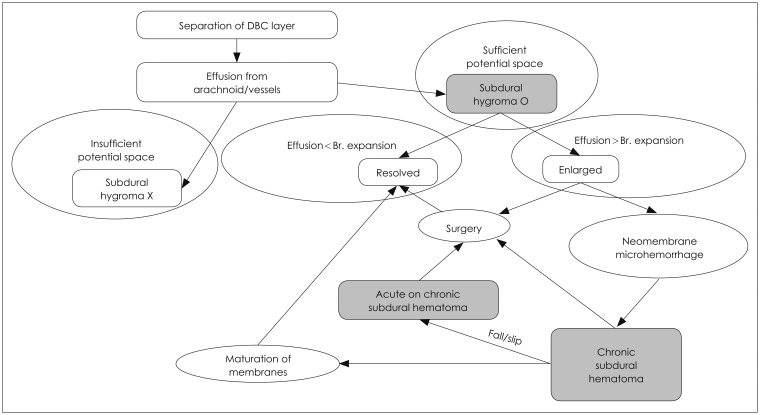
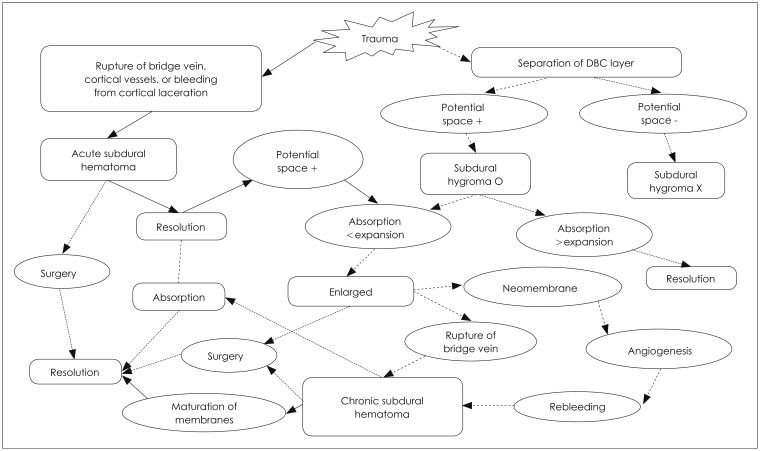




 PDF
PDF ePub
ePub Citation
Citation Print
Print


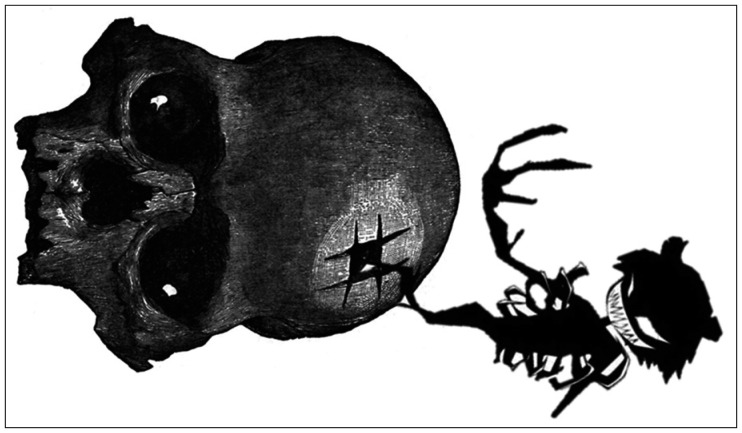
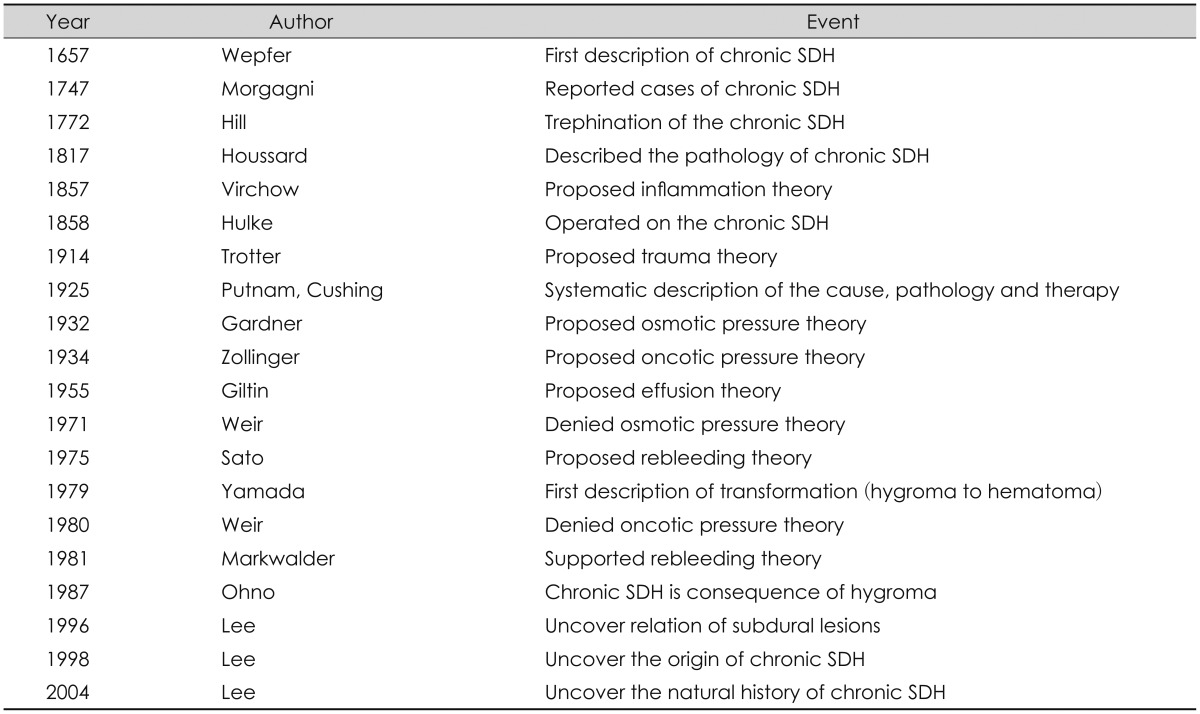
 XML Download
XML Download